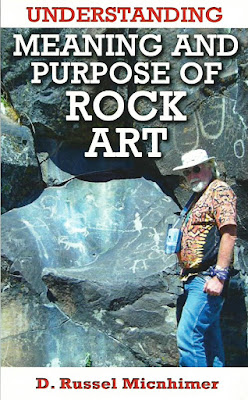UNDESTANDING MEANING AND PURPOSE OF ROCK ART, by D. Russel
Micnhimer, 2012, Pendulum Press.
Cover Photo.
I recently received a copy of a very interesting book,
Understanding Meaning And Purpose Of Rock Art, by D. Russel Micnhimer. To begin
with it is very unlike almost any other rock art book I have ever read. Unlike
most, which are crammed full of the most interesting photographs of rock art
the author can find, this volume has just a few, black and white, rock art
photos which have no captions. They are not identified as to site, location,
style, or even subject.
Five Stars for thoughtfulness.
As I read this remarkable volume I began to get the feeling
that I was perusing an exhaustive concordance of rock art studies. Now don't
get me wrong, this book does not begin to fit the actual meaning of a
concordance which is, in effect, a word-by-word index of the subject, generally
the bible (look at a copy of Strong's Exhaustive Concordance to see what I mean).
What gave me that feeling was the encyclopedic completeness with which
Micnhimer approaches his subject. He not
only touches on every aspect of his subject, the understanding of meaning and
purpose of rock art, he gives numerous aspects that most of us never thought of
before. And unlike so many one-size-fits-all theories about rock art, he
approaches it with the unique premise that we should think about it.
It was a little long on its discussion of "altered
states of consciousness" for my taste, but that does fit in with his
premise that all possibilities should be considered. To my great joy, I only
noticed the "S" word (shaman) twice, so that kind of balances out.
Indeed, he mentioned a couple of possibilities that I had not really considered
before. For many years I have consistently rejected the proposition that some
rock art consists of what we class as maps. Along with this I have been hugely
skeptical of the concept of rock art marking the location of important sites
and resources (I will not go into all that here). I was surprised, however, to
find a couple of other possibilities that I had not considered. One was that
the marking located at the resource or site could represent an ownership mark,
and the other is that a petroglyph could serve "as a tool to focus group unity and common values." It
may have "instilled a sense of
belonging to the group of those who understood the symbols, served as a
reassurance of group knowledge about periodic insecurities such as drought or
eclipses or insured that necessary tasks were undertaken that would insure the
survival of the group." (p.36)
Because Micnhimer does present all the possibilities I can
guarantee that you will read some you disagree with, but he does not say he
agrees with them either. His whole premise is that we must consider all the
possibilities before accepting, or rejecting, an answer.
I can only say that I
wish that we could require all those who have been beguiled by fraudulent gurus
like Barry Fell, Scott Wolter, and LeVan Martineau to read this book. It seems to me that it
is appropriate to end in Micnhimer's own words of conclusion. "We can realize as this discussion concludes,
that understanding the meanings and purposes of rock art is a complex one. Many
factors and facets of the task must be recognized and combined if we are to
arrive at satisfactory results. Once we have learned to ask the appropriate
questions, we can begin to populate our understanding with the appropriate
answers and hope that by doing so we can be closer to actually knowing the
intent of the original makers of these marks on stone that we know as rock art.
To the extent this book facilitates that, my marks here will have
succeeded." (p. 143)
To get a copy for yourself:
Micnhimer, D. Russel,
2012 Understanding Meaning and Purpose of Rock
Art, Pendulum Press.
$14.95 plus $4.00 shipping and handling, to:
Russel Micnhimer
P.O. Box 1653
Prineville, OR 97754






No comments:
Post a Comment